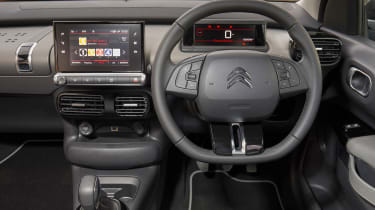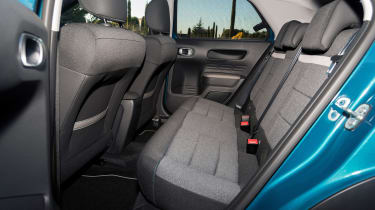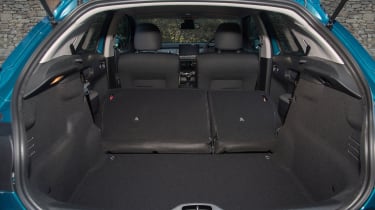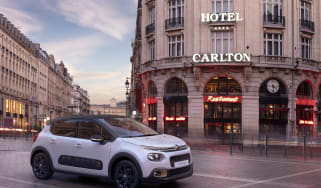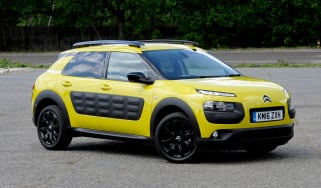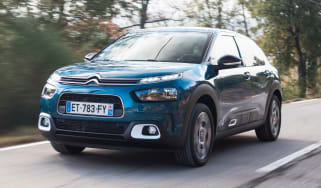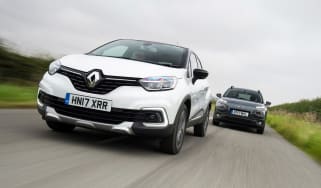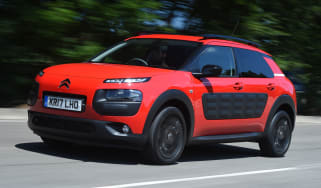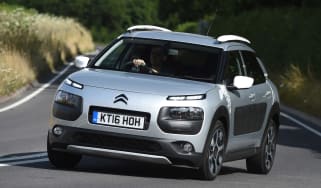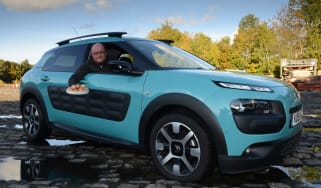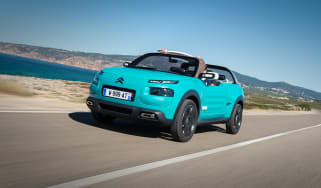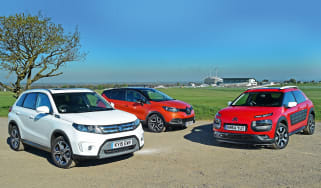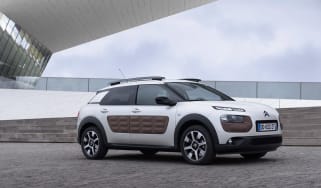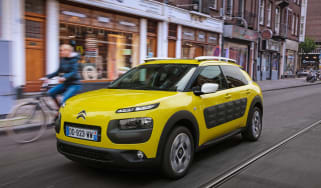Citroen C4 Cactus (2014-2020) review
The C4 Cactus is a great left-field choice, combining a stand-out design with good levels of comfort and efficiency.

This is a review of a new Citroen C4 Cactus. It was replaced by the Mk3 Citroen C4 in 2020. You can read our Citroen C4 Cautus used buying guide here...
The Citroen C4 Cactus represents a return to the past for the French manufacturer, offering unusual quirks that give it real appeal amongst its more run of the mill opposition. It’s the kind of fun and funky car for which the company was once famous.
In the past, Citroens were always soft and soothing, and with the C4 Cactus the focus has been placed very much on comfort. It’s relaxing to drive and, although it doesn’t handle quite as sharply as some other family hatchbacks, it’s still fun to hustle down a country road. The three-cylinder engines provide more punch than their power outputs might suggest, too.
Even though it’s getting towards the end of its lifecycle, there aren't many cars like the Citroen C4 Cactus currently on sale. When it was first introduced in 2014, it was positioned as a crossover to rival the likes of the Peugeot 2008 and Renault Captur.
However, after the C3 Aircross small SUV was introduced to the range, the C4 Cactus was redesigned and repositioned as a value for money hatchback. As a result, the Cactus is now marketed as a quirky alternative for buyers looking for something different from the Ford Focus and Vauxhall Astra norm.
Used - available now

2024 Nissan
Ariya
12,471 milesAutomaticElectric
Cash £25,490
2021 Lexus
UX 300e
39,392 milesAutomaticElectric
Cash £16,950
2023 Hyundai
i30
23,040 milesManualPetrol1.0L
Cash £14,801
2021 Vauxhall
Mokka
16,283 milesAutomaticPetrol1.2L
Cash £15,795One thing that hasn't changed is the individual design that the C4 Cactus is famous for. The long, narrow body, raised suspension and black wheelarch extensions all remain, as do the original C4 Cactus’s Airbumps along the side – albeit toned down by quite a bit as part of the 2018 facelift.
Inside, there are the same quirky touches from the original C4 Cactus. This includes pop-out rear windows, asymmetric air vents on the dashboard, a top-opening glovebox and minimal buttons on the dashboard. In addition, the revised C4 Cactus has added split-folding rear seats and a new suspension system designed to deliver the kind of comfortable ride that older Citroens were famous for.
Because the C4 Cactus will soon be replaced by the upcoming Citroen C4 crossover-style hatchback, it isn’t available in that many configurations anymore. There are now only two engine options for the C4 Cactus – a 99bhp 1.5-litre diesel and a 108bhp 1.2-litre petrol – and the only gearbox available is a six-speed manual.
The C4 Cactus can also now only be specified in what was once the mid-range Flair trim, though this does mean the car is reasonably well equipped. Equipment that’s fitted as standard includes the comfort suspension, alloy wheels, air conditioning, comfort seats and touchscreen infotainment.
One hangover from its time being offered as a crossover is Citroen's Grip Control system. This gives the C4 Cactus a modicum of off-road ability by altering the traction control for different surfaces, and also adds Goodyear 4 season tyres.
How much does the Citroen C4 Cactus cost?
Prices range from £22,535 for the petrol-powered C4 Cactus, to £23,315 for the diesel version. Whichever C4 Cactus you choose, you're getting an unconventional looking but spacious family car with some neat interior touches and a comfortable ride.
Engines, performance and drive
On the road, the C4 Cactus is a relaxing cruiser. The new clever suspension tech means that the car wafts over all manner of road surfaces. It’s a far more comfortable car because of it. The trade off for this is that the C4 Cactus does generate pronounced roll through the corners, and there’s more pitch and dive under acceleration and braking than in its rivals.
There’s decent grip though, so while not conventionally sporty to drive, it remains enjoyable. Improvements in sound insulation, combined with that ride, means that the Cactus is an accomplished motorway cruiser, too.
The manual gearbox was a let-down in earlier Cactus models, but the 2018 facelift has brought a noticeable improvement. It’s still not the sweetest shifting car, but much of the old car’s sloppy, vague feel has gone.
The ratios, however, remain quite widely spaced, so you have to do quite a lot of forward planning to avoid finding yourself in the wrong gear at the wrong time. This can take some hard work from the engines, which in the diesel model results in a slightly unpleasant gruff sound. However, the C4 Cactus has sharp brakes, and stops well – again, helped by the Citroen’s low weight.
Engines, 0-60 acceleration and top speed
While the C4 Cactus was once offered with a decent array of engines, the powertrain line-up now consists of a 1.2-litre PureTech petrol with 108bhp and a 1.5-litre BlueHDi diesel with 99bhp. As a result, neither engine is bristling with power, though the car’s low kerb weight does at least allow reasonable performance. Citroen claims a 0-62mph time of 10 seconds flat for the diesel C4 Cactus, and quotes a slightly faster time of 9.3 seconds for the petrol version.
At one point, the C4 Cactus was offered with a six-speed automatic gearbox. However, it has now been phased out, leaving the six-speed manual as the only available gearbox until the car’s production run ends.
MPG, CO2 and running costs
The Citroen C4 Cactus is a value for money choice. Prices start from around £22,000 (which is about the same as an entry-level Ford Focus or VW Golf), and you get a good amount of kit for your cash. Because of the slimmed down trim and engine ranges, the most expensive C4 Cactus examples aren’t massively more cash than that, either.
While there are more frugal family hatchbacks out there, the C4 Cactus is nevertheless a fairly efficient car. Unsurprisingly, the car’s most frugal engine is the 1.5-litre 99bhp diesel, which Citroen says can return up to 63.4mpg and emit as little as 119g/km of CO2.
Though it can’t match the diesel for fuel consumption, the 1.2-litre 108bhp petrol engine can also return good fuel economy – up to 51.5mpg and emissions as low as 131g/km, according to the official figures. All C4 Cactus models also come with a 50-litre fuel tank, and using official economy figures means all models can manage more than 600 miles on a full tank.
Citroen claims that the C4 Cactus will cost around 20 per cent less to run than a traditional family hatchback, too. It’s talking primarily about fuel economy, but the Airbump panels could potentially save you money on having small bodywork scratches and bumps repaired, while the low weight won’t just help at the pumps, but is likely to bring lower bills for consumables such as tyres and brake pads in the long run.
To make the C4 Cactus more accessible to buyers, Citroen offers a number of all-inclusive purchase packages. These combine a finance payment, insurance and servicing costs into a single monthly figure.
Insurance groups
Because of the limited trim and engine options, the C4 Cactus isn’t spread across a wide array of insurance groups. The cheapest model falls into group 14, while the highest spec model is in the slightly higher insurance group 16.
Depreciation
Citroen doesn’t have a marvellous record on depreciation, and don’t expect the C4 Cactus to buck the trend – at least not by much. While a standard C4 hatchback could lose as much as 70 per cent of its value over three years, the Cactus is likely to shed two-thirds of its new price, with engine and trim level making this only marginally better or worse.
To get an accurate valuation on a specific model check out our free car valuation tool...
Interior, design and technology
One thing’s for sure, the C4 Cactus is a car that embraces the Citroen brand’s quirky past, and its proportions are unlike anything else on the road: Raised suspension, a low roof, long wheelbase and rounded nose give it a shape that falls somewhere between a crossover and a hatchback.
The front end takes some inspiration from the C3, with high-set LED running lights integrated into the outer edges of the front grille, while the main headlamp units sit just below. Further back, the curvy wheelarches feature plastic extensions, and behind this the sides of the car incorporate one of its big talking points – the Airbump panels.
On the facelifted model, these have moved from their previous prime spot, across the middle of the doors, to their lower edges. While not as conspicuous - or as squidgy - as before, they still offer useful protection from potential car park dings and paint scrapes.
While the new Airbumps aren’t offered in the same range of colours as the old ones, on top spec Flair models they’re available with a choice of coloured highlights which break up the large swage of black plastic. The Airbumps have disappeared at the rear, too, which makes it look a little bit more plain than before.
Those C-pillars appear thick from the outside, although they don’t actually spoil over-the-shoulder visibility. A variety of shades are on offer, with buyers able to personalise their cars to a fair extent. You can go for a subdued colour or a vibrant finish to show off the Citroen’s unusual design elements and, in fact, the brighter the better, as it picks out the C4 Cactus’s striking design and contrasting areas.
Inside, the C4 Cactus takes inspiration from the upmarket DS range, and features a stylish layout that has a premium feel. There are asymmetric air vents on the centre console, a top-opening glovebox, luggage handle-inspired door pulls, a seven-inch touchscreen and a smart-looking oblong readout ahead of the driver.
The seats are wonderful, and the driving position is low so the C4 Cactus doesn’t feel as tall from behind the wheel as the suspension suggests. In the back Citroen has ditched the single-piece folding rear bench of the earlier cars and replaced it with split-folding, while the touchscreens that control the heating, infotainment and other vehicle functions mean the interior feels far from basic.
Some of the plastics used lower down in the cabin look cheap, but everything you touch frequently – steering wheel, gearlever and door pulls, for instance – has a high-quality feel. You get all the essentials, too, such as climate control, Bluetooth connectivity and a DAB radio.
Sat-nav, stereo and infotainment
All C4 Cactus models feature a seven-inch touchscreen, which combines all secondary control functions for the radio and climate control in one space. It’s not the best system on the market, with slightly slow response times, and the need to switch away from the nav or media menus just to tweak the climate control can become tiresome. The graphics look clear and colourful, though.
The system includes a standard digital radio, while Bluetooth music streaming and Citroen Multicity Connect, which is a 3G and GPS-enabled app-hub are included. The Flair comes with the Navigation and Hi-Fi Pack, which includes a six-speaker stereo, 16GB Jukebox and Arkamys amplifier. Because the C4 Cactus is now available only in what was formerly the mid-range Flair trim, the standard equipment list also includes features like built-in sat-nav and a six-speaker stereo system.
Practicality, comfort and boot space
Inside, the C4 Cactus feels fresh and modern, but that hasn’t come at the expense of passenger space.
The driving position is more than spacious enough, but some people may find the pedals too closely spaced. The updated model addresses two criticisms of the old car: the steering wheel now offers reach adjustment, and the seats feature variable lumbar support.
In fact, the updated seats are fantastic. New seat materials ensure the driver and front passenger have loads of support. They’re the most comfortable you’ll find at this price by some margin.
The top-hinged glovebox provides 8.5 litres of storage and the lid won’t bang your passenger’s legs when it’s opened. It’s also pretty big, partly because the passenger airbag has been moved into the roof of the cabin to cleverly maximise space on offer without compromising safety.
Dimensions and size
At 4,170mm long and 1,714mm wide, the C4 Cactus has the same basic area as a conventional hatchback. However, the Citroen is 1,480mm tall thanks to its raised suspension, so it has different proportions to hatchback rivals.
Leg room, head room & passenger space
The low roofline doesn’t hurt headroom, with enough space in the back for taller adults, while there’s plenty of leg and shoulder room, too.
The biggest compromise in the rear is the lack of wind-up windows – instead, they only pop out at the rear a few centimetres. It means back seat passengers might find things a little stuffy, although they do get spacious door storage bins as a result. Isofix child seat mounting points are standard in the rear, but fitting a child seat is tricky because they're quite hard to reach from behind the seat cushions, and the doors don’t open as wide as in some rivals.
Boot space
The C4 Cactus was initially fitted with a one-piece rear bench, but 60:40 split folding rear seats were added at the facelift and are now standard across the range. The boot has a 358-litre capacity with the rear seats in place, which is slightly less than you get in a Volkswagen Golf.
Fold the seats flat, and this rises to a maximum of 1,170 litres. The load lip is quite high though, and this setup means you have to trade carrying rear passengers for luggage if you’ve got larger items on board. There’s also exposed metal in the boot which could scratch if you’re carrying harder, bulkier items
Reliability and safety
Citroen’s vision for the C4 Cactus was to remove anything that wasn’t entirely necessary; by offering pop-out rear windows, fewer buttons on the dash and no adjustability for the gearbox, steering and engine mapping, the company felt there was less that could go wrong. This is especially the case now the range and options lists have been trimmed down – the C4 Cactus is only available in one spec and, bar a blind spot monitoring assist and cosmetic options like paint colours, there’s little else you can add to the car.
Even so, the crossover offers most of the kit you’d expect from a thoroughly modern family car. Equipment such as a reversing camera, hill start assist, six airbags, tyre pressure monitors and cruise control all feature, so there’s still scope for gremlins to take hold.
A lot of the kinks should hopefully have been ironed out by now: after all, the C4 Cactus has been in production for a while, and it uses a lot of technology that’s been featured across multiple Citroen models. It sits on an extended version of the platform that underpins the Citroen C3 supermini, while the standard touchscreen is similar to the one found in the 308 hatch from sister brand Peugeot.
The petrol engine is used across the Citroen range, and the 1.5 BlueHDi is a unit that's being added to a wide range of models, so will have been extensively tested to ensure its reliability.
The company has been trying hard to shake off its reputation for poor build quality and patchy reliability. Customer feedback from our Driver Power surveys indicates there has been some improvement, with Citroen finishing 24th out of 30 manufacturers in 2019 and moving up to 18th place in 2020. The C4 Cactus finished third from bottom, however, in our most recent Driver Power poll.
One byproduct of cutting 200kg from the kerbweight compared to the previous generation C4 hatch is that consumables such as the brake pads and tyres should function better for longer.
Unfortunately, by producing a simpler car, Citroen has achieved a disappointing result in Euro NCAP crash tests. The C4 Cactus scored only four out of five stars in the independent assessments when it was tested in 2014, with a low rating in the safety assist category.
Still, the rest of the Citroen’s standard safety kit is well up to the class benchmark, and includes six airbags, stability control and cruise control with a programmable speed limiter.
Warranty
The C4 Cactus comes with a three-year/60,000-mile warranty. This isn’t much to shout about when Kia offers a seven-year/100,000-mile package, while the likes of Hyundai and Toyota provide five years’ cover with their new cars.
Servicing
Citroen servicing is usually pretty cost-effective, and the C4 Cactus shouldn’t prove an exception being based on the firm’s supermini underneath. Dealers offer interest-free payment plans, too, so you can get two or three years’ worth of maintenance with fixed monthly instalments.

